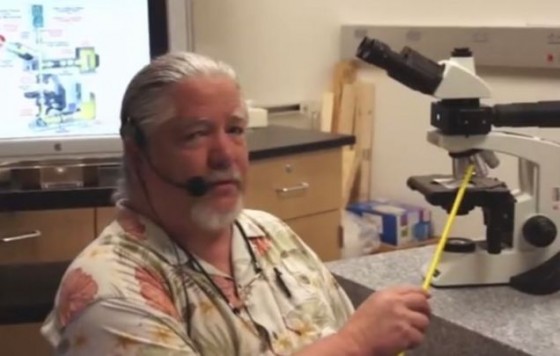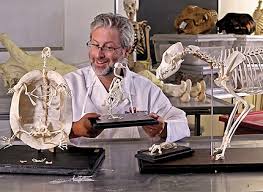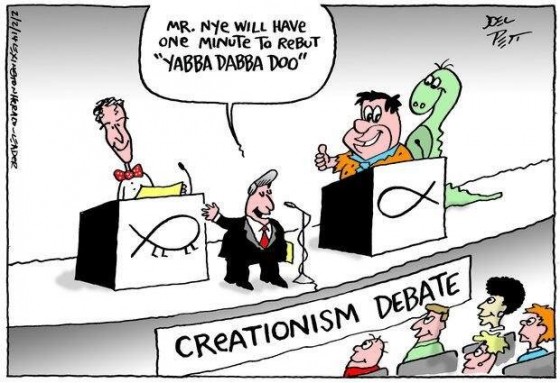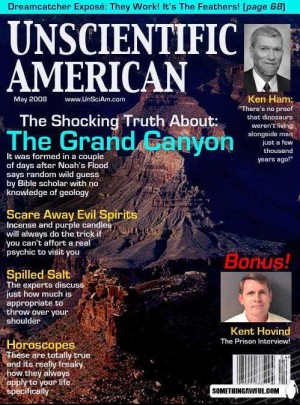by
Donald Prothero, Sep 04 2014

CSUN lab technician Mark Armitage, was fired after publishing creationist ideas and preaching creationism in his Biology Department job
A few weeks ago, a story broke in the news about a creationist working in the Biology Department at California State University Northridge (CSUN), who was fired for pushing creationism in the department. The story exploded across the internet, especially among the creationist organizations who are once again claiming persecution by scientists. CSUN apparently botched both the hiring of this guy, and now his dismissal, so they’ve been sued and this is going to play out badly for them in the courts. But the entire case raises larger issues that are not easily resolved.
First, the facts of the case. The plaintiff is Mark H. Armitage, a microscope technician (not a professional biologist). He did some undergrad work in Biology at University of Florida, but didn’t graduate. Then he got his B.S. in Education from Jerry Falwell’s fundamentalist Liberty University, and his M.S. in Biology (parasitology) from the Institute of Creation Research, an unaccredited fundamentalist organization that has since left California and closed down its graduate program. As many others have shown, the ICR “Master’s Degree” was a sham, consisting of little more that incompetently done book reports and quote-mining from legitimate scientific literature with a creationist spin, not legitimate scientific research. I’ve seen a number of “master’s theses” from there—they are so bad they wouldn’t even pass for a freshman book report. Prior to his employment at CSUN, he was employed as a microscope technician at a variety of Christian schools. But he has no Ph.D., no formal training or peer-reviewed published research in the histology he was working on. He’s just a humble lab tech on a 2-day a week part-time gig, with no guarantee of employment from one semester to the next. His sole job is to maintain and keep track of the microscopes in a big department with hundreds of them, not to teach courses or do research. Continue reading…
comments (28)
by
Donald Prothero, Jul 30 2014

Neil deGrasse Tyson on “Real Time with Bill Maher”, July 25, 2014
In a previous post, I commented on how the Religious Right got upset when “Cosmos” aired last spring. They were angry when “Cosmos” mentioned Giordano Bruno or scientists who were persecuted by religious extremists during their pursuit of truth. They recoiled in horror at how often “Cosmos” reminded us of our cosmic insignificance compared to the scale of the universe, or from the perspective of geologic time. They raged about the fact that “Cosmos” spent an entire episode on on evolution, and the topic of evolution came up repeatedly. And lots of pro-business types hated the episode about Clair Patterson’s lonely fight against the lead manufacturers, who were invisibly polluting the world and poisoning us all. The climate deniers hated that “Cosmos” mentioned anthropogenic global warming many times.
Nonetheless, most of the reviews for “Cosmos” were overwhelmingly positive and there’s good reason to think that it reached much of its target audience, and inspired a lot of people to think about scientific questions in a way that hasn’t happened since the original Sagan version of “Cosmos.” I have been rejoicing at the recent resurgence in the media popularity of science and evolution lately, especially after Bill Nye’s defeat of Ken Ham, the great response to Neil Shubin’s PBS documentary “Your Inner Fish,” and of course, the huge popularity of Neil DeGrasse Tyson and “Cosmos”. Finally, we have several major scientists (Nye, Tyson, Shubin) who are popular in the media, especially on trendy shows like “The Daily Show” and “Colbert Report” as well as national news networks like MSNBC and CNN. They are national celebrities for all the right reasons (smart, articulate, telling people the truth about science and the world), rather than being famous because of reality TV or sports or entertainment. They are becoming widely known, and doing a great job of promoting science against the tidal wave of junk science and pseudoscience in the media. There hasn’t been such high-profile popularity of scientists since the days of Sagan himself. It’s about time! Continue reading…
comments (32)
by
Donald Prothero, May 28 2014

When you break down the polls and question Americans about their acceptance of specific scientific ideas like continental drift and animal evolution, a much higher percentage are NOT creationists
For decades now, the Gallup Poll has surveyed Americans about their belief in evolution and creation. Year in and year out, the numbers seem to remain constant: about 40-45% of Americans appear to be Young-Earth creationists (YEC). The exact phrasing of the question is as follows:
Which of the following statements comes closest to your views on the origin and development of human beings: human beings have evolved over millions of years from other forms of life and God guided this process, human beings have evolved over millions of years from other forms of life, but God had no part in this process, or God created human beings in their present form at one time within the last 10,000 years.
For decades about 44% of the respondents agree to the last answer (YEC), another 37% chose the first answer (theistic evolution, ID creationist), and only 12% favor the second answer (non-theistic evolution). Gallup wrote these questions decades ago before there was much understanding of how the framing of a question can bias the answer, and for decades, they have kept the question the same so comparisons remain consistent. But social scientists know that polls can be very misleading, especially in the way the question is framed to force certain responses. For example, the Gallup poll only gives us three possibilities, and load two of the answers with “God”, which is an obvious bias right from the start. In addition, there is good evidence to suggest that human evolution is the real sticking point, and that most people don’t care one way or another if non-human creatures evolve or not. What if we asked people what they thought about specific scientific ideas, independent of emotional issues like “God” and “humans”?
Continue reading…
comments (26)
by
Donald Prothero, Apr 09 2014

A review of Your Inner Fish, a three-part documentary series airing on PBS beginning on April 9, 2014
In 2008, Neil Shubin published his best-selling book, Your Inner Fish: A Journey into the 3.5-Billion Year History of the Human Body. Based on his experience teaching medical school anatomy at the University of Chicago, the book explored the evidence of our evolutionary past demonstrated in the peculiar jury-rigged anatomy of humans. Interspersed with the anatomical evidence of evolution were stories about his field work discovering important fossils that showed the transition from fish to amphibians (Tiktaalik), as well as other important finds. Shubin’s research is not only in anatomy and paleontology, but also in evolutionary developmental biology (“evo-devo”), so there were many stories in the book detailing the new discoveries in genetics that explain the oddball poorly-designed way we are constructed, and how these genetic mechanisms were inherited from our ancestors. The book was named “Best Book of the Year” by the National Academy of Sciences. After his earlier career at the University of Pennsylvania, Shubin is currently the Robert Bensley Distinguished Service Professor at the University of Chicago and Associate Dean for academic strategy of the university’s Biological Sciences Division. He was elected to the National Academy of Sciences in 2011. Continue reading…
comments (10)
by
Donald Prothero, Mar 26 2014

The “Creation Museum” in Petersburg, Kentucky, ironically built upon rocks which disprove Noah’s flood
A foolish man, which built his house upon the sand—Matthew 7: 24-27.
Speak to the earth and it shall teach thee—Job 12:8
During the Ham on Nye debate last February 4, Bill led off with a great example to throw Ken off balance. He pointed out that (ironically), the Creation “Museum” itself was built upon rocks which refuted flood geology! Bill even brought a piece of fossiliferous limestone from a road cut nearby to show that it was full of fossils, delicately preserved, and not the kind of thing a flood would produce. He explained it briefly, but I don’t know how many people got the point—and given the humorless nature of most creationists who don’t catch on to sarcasm and snark, I doubt they even noticed the irony that their entire model was refuted by the rocks beneath them at that very place.
Let’s look at the geologic background to this concept. First of all, how do limestones form? Geologists know from studying them all over the world, and looking closely at them in ancient settings, that limestones are produced by the accumulation of fragments of calcareous animals and plants (shell fragments, corals, pieces of calcareous algae) in warm, shallow, clear tropical waters, with no mud or sand from land that would clog the gills of the shelly organisms or corals, or make the water dark and muddy. Since many of these organisms (especially corals) only form big reefs in warm tropical waters, and since much of the reef community is plants (not only the calcareous algae, but also the algae symbiotically living in reef coral polyps), the water must be very shallow and clear to allow light penetration. Consequently, modern limestones are formed in shallow clear tropical waters far from the mud of land-based rivers: the Bahamas, Bermuda, Yucatan, the Atlantic Coast of Florida (but not the Gulf side, where Mississippi mud darkens the waters), the Persian Gulf, and the southwest Pacific and Great Barrier Reef of Australia. Nowhere else! Not only is this a very restricted setting, but under no circumstances do limestones (today or in the past) show any evidence of being formed in the muddy, turbulent, cold waters of a typical flood—or even a supernatural flood. If you look at them closely, they are accumulations of layer after layer of fossil communities, slowly building on top of each other in quiet waters, often with delicate organisms (such as the stick-like bryozoans and delicate corals and sponges) buried in life position, with no evidence that they had been battered and toppled by the powerful energy of flood waters. Knowing this, right away we can refute “flood geology”, because there are many places in the world with huge piles of limestone, each made of layer upon layer of delicate fossils, that cannot be made by flood energy. Heck, even the creationists’ favorite example, the Grand Canyon, is built with many limestone layers: the Muav Limestone near the base, the huge thickness of Redwall Limestone at the cliff break, and the Kaibab and Toroweap Limestones that cap the rim. Continue reading…
comments (32)
by
Donald Prothero, Feb 26 2014

One of the recurring themes at the Feb. 4 debate between Bill Nye and Ken Ham was Ham’s continuously harping on a supposed distinction between “observational science” (science we can observe in real time) and “historical science” (science that must be inferred from the past). This strange distinction is almost unique to Ken Ham, although I’m sure he borrowed from older creationist writings somewhere, since I remember reading about it when I researched creationism in the 1980s. Nevertheless, Ham kept pounding on it again and again, refusing to talk about any scientific evidence that couldn’t be witnessed in real time.
As many scientists have discussed, this distinction is complete bunk, and only Ken Ham and his followers seem to think that it makes any sense. Naturally, he pounds on this phony, self-serving, artificial distinction because it plays in his favor. Each time Bill pressed him on one point or another, Ham retreated behind his dodge of no one can know anything of “historical” past, then made the ridiculous assertion that the only reliable source of information about the past is the Bible. (Bill was too much of a gentleman to challenge him on this and ask Ken how he knows this. As Ham always says, “Were you there?”). Most of science tells us that the earth is old, that life has evolved, and so on. Ham wants to throw all this information away, so he creates a convenient but ridiculous distinction that serves his purposes—but bears no relation to what real scientists do or think. Continue reading…
comments (16)
by
Donald Prothero, Feb 12 2014

I write this post just a few hours after watching the Ham on Nye “debate” last night. I’m still mulling over the details, and checking on line to see the evolving reactions to the events, but it’s running through my head so much now that it’s time to write it down so I can get back to work. Fittingly, it will post on February 12, Darwin’s 205th birthday. It couldn’t be more appropriate.
Let me start at the beginning. I was at Michael Shermer’s New Year’s Eve party last December 31st. This is not just your average New Year’s Eve party: it’s in Shermer’s magnificent glass-walled view house at the foot of the San Gabriel Mountains with an amazing panorama of the lights of the city below. He had his telescope out on the porch, and we all got a view of the four Galilean moons of Jupiter. The guests include Mr. Deity and “Lucy” (Brian Keith Dalton and Amy Rohren), D.J. Grothe of the James Randi Educational Foundation, lots of scientists including several JPL people, Shermer’s grad students—and Bill Nye. Late in the evening, Bill comes up to me and mentions that he had agreed to debate Ken Ham. He knew I’d beaten Duane Gish back in 1983, and that I was familiar with battling creationism over the past 35 years. After I talked to him and realized that the debate was set and he could not back out, I offered to help him prepare. Then about 3 weeks ago, he emailed me and we made arrangements. He spent a day in Oakland at the National Center for Science Education (NCSE), where a bunch of their staff helped him analyze Ham’s past debates and arguments (they have archives of every creationist out there), and suggest strategies. Since Ham had voluntarily set the debate topic to defend the scientific value and truth of the Bible, Bill was not in the usual dilemma of having to defend and explain complex topics of evolution. Normally, creationists employ the “Gish Gallop” to keep the scientist on the defensive, trying to undo the mistaken ideas and lies the creationist has just said, and replace it with a more complex explanation. Instead, the NCSE staffers recommended that Bill use this to his advantage, and do a “reverse Gish Gallop”: pile on the examples one after another, so that Ham wouldn’t have time or ability to answer them all. Continue reading…
comments (43)
by
Daniel Loxton, Jan 07 2014

Ann Reid. Photo by Chris Condayan, asm.org. Courtesy NCSE
Our colleagues at the National Center for Science Education have welcomed their brand new Executive Director Ann Reid, who began her new job yesterday (January 6, 2014). A molecular biologist, Reid is the successor to outgoing executive director Eugenie C. Scott, who held the post for an astonishing 27 years. On her retirement, Scott became the Chair of NCSE’s Advisory Council.
With its mission to defend the teaching of evolution and climate science, the NCSE is among the most essential organizations to operate within the general sphere of scientific skepticism. It is also a shining example of the power of constrained focus. I happen to know, for example, that Genie is a fellow “Bigfoot skeptic”: she is not only the Chair of the venerable Bay Area Skeptics, but also a physical anthropologist with a specific interest in pseudoscience related to her field—which is to say, Bigfoot and the Yeti (video). Nonetheless, the NCSE has never tried to tackle a broad portfolio of paranormal and pseudoscientific topics. Instead, they picked a tightly focused mandate, and made themselves a credible, reliable national voice on that topic in particular. Very often, simplicity is strength. Continue reading…
comments (1)
by
Donald Prothero, Dec 04 2013

Our ancestor? Not likely…
This past week I’ve been getting all sorts of questions from people about the strange study just reported in the British tabloid
The Daily Mail. Some scientist in Georgia claims that humans are formed by hybridizing apes and pigs. At first, I thought it was a hoax or some outrageous parody or Poe, or possibly an example of the media distorting the original results beyond all recognition, because it’s so crazy that it’s hard to imagine any legitimate scientist making that claim. But a little digging shows it’s not a hoax or parody: there
is a crackpot scientist out there who had made the claim, and naturally the media loved it and published it without any fact-checking (as usual).
First, the assertion: a Georgia geneticist, Dr. Eugene McCarthy (a sad coincidence that he has the same name as the groundbreaking anti-Vietnam War presidential candidate in 1968) claims that humans have evolved by hybridization between a boar and a female chimpanzee. Anyone trained in genetics or evolution will immediately do a double-take reading this, because it so far off the edge of crazy that it cries out to be examined further. So you click on the link, and what do you find? Is there a ton of genetic data, peer-reviewed and published in a respectable journal, that would allow us to take the claim seriously? No, not even close. Not only is it a wild claim made on a personal website without any peer review (the classic sign of crackpot science), but the evidence is not genetic at all, even though the author claims to be a legitimate geneticist! Once you go to the original link, you find that it’s a list of superficial fleshy similarities between the soft tissues of pigs and humans: naked skin, thick skin, sweating, protruding cartilaginous nose, eyebrows, heavy eyelashes, short thick upper lip, earlobes, and a long list of minor similarities in the skeleton and rest of the anatomy. Anyone who is a vertebrate anatomist familiar with phylogenetics will immediately notice that these are highly correlated characters that all occur together when a a lineage becomes less hairy, or else they are symplesiomorphic features shared by most placental mammals. What the list doesn’t point out is all the huge and fundamental differences in the skeleton he doesn’t mention, especially the unique “cloven-hoofed” even-toed hands and feet of pigs with the “double-pulley” astragalus bone, which unites them with all other artiodactyls (the “even-toed” hoofed mammals), a feature seen in no primate or any other organism on earth; and the huge differences in the skull, braincase and ear region that allow any competent anatomist to immediately distinguish a pig from any primate. Once again, it’s a classic case of someone not trained in a given field (anatomy and phylogenetics) dabbling in someone else’s orchard, cherry-picking data he doesn’t understand, and ignoring everything that flatly contradicts his ideas. Surprisingly, the one thing I would expect him to list—the low-cusped bunodont dentition of pigs and primates—isn’t mentioned (again, it’s convergent evolution since pigs and many primates have an omnivorous diet, as do bears and peccaries, who also convergently evolve bunodonty). As P.Z. Myers pointed out (he calls it the “MFAP hypothesis”, “monkey fucked a pig”), it’s very similar to the long-discredited “aquatic ape” theory of Elaine Morgan—cherry-pick a handful of superficial anatomical characters associated with loss of body hair in apes and tell a just-so story, ignoring all the rest of the evidence. Continue reading…
comments (10)
by
Donald Prothero, Nov 20 2013

In previous posts, I’ve written about creationist Ken Ham’s efforts to get an “Ark Encounter” theme park built near his Creation “Museum” in Petersburg, Kentucky. When it was first announced, they promised to make it the Seventh Wonder of the World, and even the Governor and State Legislature of Kentucky agreed to tax breaks and new roads to help them out. The Ark model will just be the centerpiece of a huge amusement park to sucker in the rubes. According to Mark Joseph Stern, writing for Slate.com:
Like most of Ham’s projects, Ark Encounter promises to be a heady combination of hands-on fun, perverse indoctrination, and apocalyptic terror. According to Ham’s fundraising newsletters, the ark itself will contain three levels of “edu-tainment” about Noah’s menagerie—which, as noted in his magnum opus Dinosaurs of Eden, included every species of dinosaur, even T. Rex. (How did they fit? As always, Ham has an answer: “When it came to the very few dinosaur kinds that grew to a very large size, God probably sent ‘teenagers,’ NOT ‘fully grown adults’ on the Ark.”) The ark’s exhibits will likely follow the lead of the Creation Museum, intertwining spectacularly weird animatronics, comically idiotic sophism, and menacing warnings of cultural decay.
Continue reading…
comments (2)










